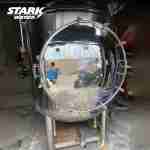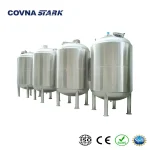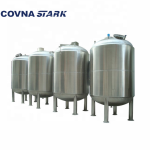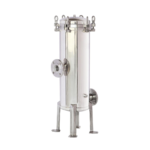Introduction: Many Systems Don’t Actually Need a Buffer Tank
In industrial water treatment projects, terms like “buffer tank” and “pressure tank” are often used interchangeably—or worse, misapplied entirely. While both involve managing water volume and flow, their roles in a system are fundamentally different.
Many process diagrams or engineering specifications call for a buffer tank, but in reality, the function that’s needed—such as pressure stabilization or pump protection—can be achieved more efficiently with a properly sized pressure tank. Using a buffer tank where it’s not necessary can lead to wasted space, added cost, and increased maintenance complexity.
In this article, we’ll clarify the difference between these two tank types, explain when a buffer tank is truly required, and show you why in most industrial scenarios, a pressure tank is the smarter choice.
What Is a Pressure Tank – And Why It’s So Versatile
A pressure tank is a sealed vessel designed to hold water under pressure using a gas cushion—usually air or nitrogen—inside the tank. Its primary function is to stabilize system pressure, reduce pump cycling, and ensure a constant flow rate in pressurized pipelines. Unlike simple storage tanks, pressure tanks actively participate in flow control.
Key Benefits of Pressure Tanks:
- Constant pressure: Maintains steady outlet pressure, even during demand fluctuations.
- Protects pumps: Reduces pump on/off cycles, extending pump life and lowering energy consumption.
- Compact footprint: Stores energy (pressurized water) in a small volume—ideal for space-constrained facilities.
- Low maintenance: Modern diaphragm or bladder tanks are easy to inspect and service.
Pressure tanks are commonly used in RO systems, booster stations, fire suppression systems, and industrial rinse cycles. They’re essential in applications where maintaining consistent water pressure is critical for process stability or equipment protection.
Explore our stainless steel pressure tank solutions here:
STARK Pressure Tank Series
What People Call a Buffer Tank – And When It’s Not Needed
The term “buffer tank” is often used loosely across industries to describe tanks that serve as volume reserves, thermal dampeners, or surge absorbers. In HVAC systems, buffer tanks are used to prevent short cycling of chillers or boilers. In hydronic loops, they moderate temperature fluctuations. However, in many industrial water applications—especially in reverse osmosis (RO), rinse, or clean water systems—buffer tanks are either redundant or can be replaced with smarter configurations.
In these contexts, what’s actually needed is pressure stabilization, not volume buffering. Installing a buffer tank when the real requirement is consistent flow can lead to:
- Unnecessary space usage
- Higher installation and material costs
- Complex cleaning and tank maintenance
- Reduced system response time to pressure changes
Instead of defaulting to a “buffer tank,” consider using a properly sized pressure tank in conjunction with a stainless steel storage tank equipped with level control and sanitary fittings. This setup offers better hygiene, flow responsiveness, and ease of integration into your existing process layout.
Pressure Tank vs Buffer Tank – Key Differences & Misconceptions
While both pressure tanks and buffer tanks involve fluid storage, their design logic and use cases are fundamentally different. Below is a breakdown to help clarify where the confusion often arises—and why pressure tanks are usually the better fit in industrial water systems:
| Feature | Pressure Tank | Buffer Tank |
|---|---|---|
| Operating Pressure | Pressurized (1–10+ bar) | Atmospheric or low-pressure |
| Function | Stabilize pressure, protect pumps, control flow | Store excess volume, smooth flow/temperature changes |
| Typical Applications | RO systems, booster pumps, rinse cycles, fire systems | Chilled water loops, heating systems, tank return dampening |
| Size and Space | Compact and energy-efficient | Larger footprint, not ideal for tight facilities |
| Maintenance | Simple: bladder inspection or valve check | More complex: sludge buildup, cleaning access needed |
| Recommended by STARK | ✔ Yes – available in multiple materials and sizes | ✖ Not supplied – recommend pressure + level-controlled tank instead |
The takeaway: if your system requires flow consistency, pressure control, or pump protection, a pressure tank is almost always the smarter and more compact solution.
Real-World Applications: Use Pressure Tank Instead
Case 1: RO System Stabilization without a Buffer Tank
A client initially requested a buffer tank downstream of their reverse osmosis unit to “balance flow before use.” After analyzing the system, our engineers recommended replacing the buffer tank with a 200L stainless steel pressure tank paired with a level-controlled feed tank. The result: stable outlet pressure, reduced pump wear, and 30% savings in space and installation time.
Case 2: Pharmaceutical Water Line Using CIP-Ready Pressure Tank
In a pharmaceutical-grade clean water system, the customer originally specified a buffer tank for volume balancing. We replaced it with a SUS316L pressure tank (mirror-polished interior, sanitary fittings, pressure relief valve) which ensured both hygienic design and precise pressure regulation for critical equipment.
Case 3: Booster Pump System in a Limited-Space Utility Room
A utility room in a hospital had only 2.2 meters of vertical clearance. The installer considered a buffer tank but struggled with space and height. Instead, a horizontal stainless steel pressure tank from STARK was selected, mounted parallel to the pump line. The solution preserved floor area and delivered stable output with minimal cycling.
Conclusion: Design for Logic, Not Labels
When it comes to selecting the right tank for your water system, the label “buffer tank” may not always represent what your process truly needs. In many industrial applications, flow stabilization, pump protection, and system pressure control are better achieved using a well-engineered pressure tank.
At STARK, we specialize in stainless steel and custom pressure tanks designed for critical water treatment systems—from RO units and booster lines to pharmaceutical and fire protection networks. We help clients replace outdated buffer tank configurations with smarter, space-saving pressure solutions tailored to real-world operating conditions.
Still unsure whether your system needs a buffer tank or a pressure tank?
Contact our engineering team today for a technical review, layout support, and product recommendation tailored to your project.





